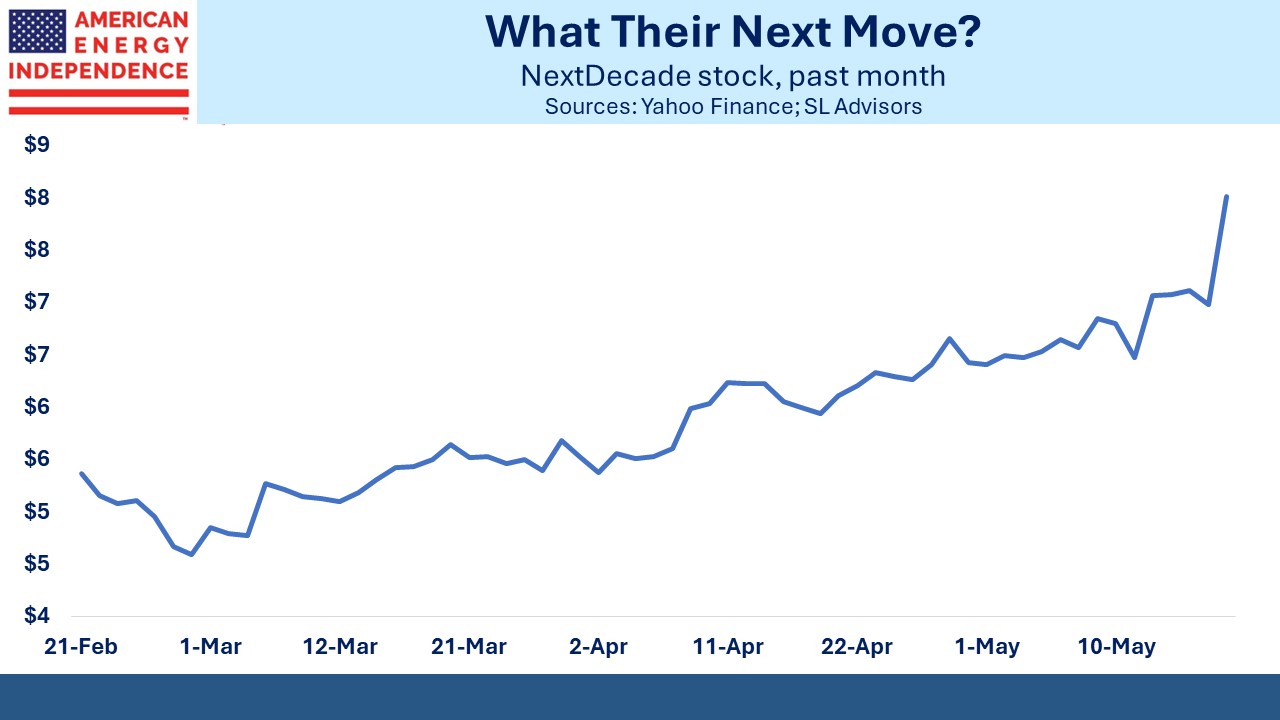What’s Next For NextDecade?
NextDecade (NEXT) has drawn plenty of investor questions over the past ten days. It began with their most recent 10Q, filed with the SEC on May 13th. The phrase, “... there is substantial doubt about the Company’s ability to continue as a going concern.” wasn’t pleasant reading for many. How can a company that reached Final Investment Decision (FID) on trains 1-3 for its Rio Grande LNG export facility last year have any doubts about its survival?
Investors initially looked past the company’s reiteration that it has secured funding for Stage 1 (Trains 1-3). The “going concern” language referred to Stage 2 (Trains 4-5) which is not financed and hasn’t yet reached FID.
The stock swung wildly over the two trading days (May 10-13), covering a range from $7.41 to $6.37. On Tuesday 14th it recovered strongly, perhaps as investors reassessed.
Our opinion remains that the market is giving little if any credit for the economics of Stage 2. The costs of completing Trains 4-5 should be lower than 1-3 because the site will have already undergone its initial preparation. So we think it’s undervalued. However, the company disappointed investors when they reached Stage 1 FID last July because they wound up with only 21% of the economics.
My partner Henry and I often debate how to assess this. I think they negotiated poorly. Global Infrastructure Partners (GIP) and TotalEnergy outsmarted them. No doubt capital and offtake agreements are vital to the project. But if you’re acquiring the land, capital, infrastructure partner and customers it seems that should be worth more than a fifth of the resulting business. NEXT had led investors to expect a 30%+ share, so on this they disappointed.
The counter, as Henry points out, is that they’re in a much stronger position to negotiate over stage 2 where we expect them to achieve a higher share than Stage 1. Even though Stage 2 is two trains versus three in Stage 1, it’s plausible that Stage 2 could be more valuable.
The LNG permit pause, ill-advised though it is, has helped NEXT. This is because, crucially, they have permits for Stage 2 already. Energy Transfer, whose planned Lake Charles LNG project is currently hostage to the pause, has seen negotiations slow because of the uncertainty. Japan’s Minister of Economy, Trade and Industry Ken Saito has sought clarification since Japanese companies are among the potential customers.
NEXT is not impacted by this. As if to demonstrate, on Monday they announced a 20-year 1.9 million tons per annum offtake agreement for Train 4 (ie Stage 2) with ADNOC of the United Arab Emirates. ADNOC additionally acquired an 11.7% stake in Stage 1 through GIP.
NEXT’s 10Q reminded that they plan to resolve the going concern issue by, “obtaining sufficient funding through additional equity, equity-based or debt instruments.”
This deal didn’t raise any equity for NEXT, so the possibility of a secondary is still there. But it did provide welcome confirmation of Stage 1 economics for the current investors.
NEXT hopes to reach FID on Train 4 later this year.
Deals can get done before FID has been reached on a facility, as NEXT has shown repeatedly in recent years. Permit uncertainty is a more difficult hurdle to overcome.
The contrast with Tellurian (TELL) is stark. Former CEO Charif Souki pursued deals that let TELL retain natural gas price exposure, a risky approach that made it impossible to obtain financing. Agreements expired as TELL failed to make progress. Souki left a job that had already awarded him success bonuses even though he hadn’t been. He was better at negotiating payment for performance in advance than in making TELL successful (see What’s Next For Tellurian?).
In other news, JPMorgan reiterated their bullish outlook on Cheniere (CEI) with its 11% Distributable Cash Flow (DCF) yield and highly visible cashflows. One of my favorite charts is from Wells Fargo where they rank companies in the sector based on what percentage of EBITDA they need to reinvest as maintenance capex.
CEI is top on this metric. LNG terminals don’t require much spending to preserve their functionality.
Earnings for the sector generated few surprises other than CEI’s predictable beat of expectations. Midstream energy infrastructure businesses are generating steadily increasing cashflow. Yields betray that a substantial percentage of investors remain skeptical. Fund flows are modestly positive but there is no irrational exuberance evident. Energy is the best performing S&P sector for the past three years, but to us it still looks like we’re in the early innings.
We have three have funds that seek to profit from this environment:
